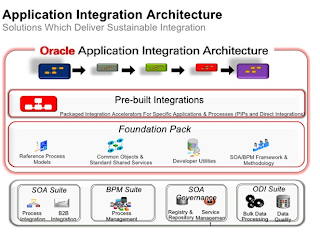SOA Governance can be defined as the interaction between policies (what),
decision-makers (who), and processes (how) in order to ensure SOA success.For Architect,They need to have goverance initiative When implemeting SOA based soln,when SOA roadmap is built,we need to have SOA Governance roadmap, understand risks,appropriate goverance process,how manage lifecycle,How manage change impact analysis,appropriate processes/poliicies/tools.
SOA governance provides ability to quickly and continuously translate and transmit business strategy and requirements into processes,policies and controls that will guide evolution of company's infrastructure and enterprise
Failure to provide effective SOA governance exposes your organization to serious
risks resulting from
• Insufficient adoption of services
• Fragmented approaches to SOA
• Resources wasted on services that can’t be reused
• Rampant and redundant service creation across siloed SOA initiatives
• Ineffective communication of priorities and best practices
• Cultural resistance to change
effective governance ensures that communication, collaboration, and the flow of information
keeping SOA initiatives and investment connected to the enterprise to deliver sustainable business value
Role of an Architect in SOA Governance model
->It is architect who helps in defining the SOA governance fro an organization and success of governance initiative rests on Architect.
Following practices provide good foundation upon which organization can extend and grow their SOA capabilities:
1.Translate the vision into corporate strategy:
This could be done by building reference architecture & implementation road map to achieve business goals.Governance reqs are met at each stage of implementation process by incorporating some checkpoints/controls.The startegy must be communicated to stakeholders through guidelines/policies to make sure evrything from high-level metrics to detailed best practices is accessible to everyone-from executive to developer.To gain the most reusability across lines of business, departments, and projects, it is important
to create standards to which architects can design solutions.
2.Enforcing this strategy
Standards,policies and process gates(best practices) are created to support this strategy to ensure that project meet requirements/resources.
Guidelines for priortizing service requests need to be made.SOA staregy should be aligned with where your business is going and develop a concrete idea of what you expect from SOA investments.SOA Roadmap outlines projects to be implemented with SOA to ensure that you deliver business and SOA Strategy.
3.SOA Visibility
SOA Visibility needed to be established and maintained with constant analysis to make good decisions.An automated and structured tool for SOA monitoring,enforcement,traceability and compliance need to be used.Use this information to support a product lifecycle
approach, complete with a versioning strategy, service retirement, and upgrade path, to minimize disruption to your customers.
4.Support for innovation and protect performance
A well-managed SOA nurtures innovation by providing an enevironment in which services and systems can be used in creative,unanticipated ways which provide unexpected business value.Effective governance must balance this flexibility with system performance through continuous monitoring.
5.Tracking and promoting SOA Success
Good SOA governance depends upon on information up and down value chain so communicating goals and progress to all stakeholders help in ensuring both top-down and bottom-up support for SOA.To ensure SOA success, you should enact policies and supporting processes that support the
delivery of the SOA Roadmap. You should communicate them widely, and then monitor their
implementation and make adjustments as you go. This is the essence of governance with
SOA—enacting policies and procedures to ensure the timely and appropriate execution of
your SOA Roadmap.
According to a strategic planning assumption by Gartner Group’s Paolo Malinverno, through 2010, the lack of working governance arrangements will be the most common reason for the failure of SOA projects (0.8 probability). Conversely, companies that have established governance to help individuals make good decisions within the context of the problem space, have matured their SOAs successfully. These companies have also achieved an effective layering of SOA
capabilities in areas such as architecture, technologyinfrastructure, operations, information, governance, people and organizational structure, portfolios, project execution, and finance.A SOA Roadmap built using a maturity model, such as Oracle’s Five-Level SOA Maturity
Model: Level 5 SOA,1 allows companies to begin the SOA journey, and manage the transformation to SOA by building on each successive step, and ultimately delivering the SOA benefits expected: service reuse, improved integration, interoperability and business agility
To meet business,EA and SOA goals,policies must be enacted across different business areas:architecture,technology infrastructure,information,finance,portfolios,people,projects and operations.This is the role of
governance: i.e. policies, which need to be designed and enacted to ensure this alignment. The format and medium for policies may be different - some policies can be captured and enforced in technology.The greatest benefit and return on investment with SOA occurs when companies stop trying to maximize investments locally (silos) and start maximizing all assets across the entire
enterprise.




